
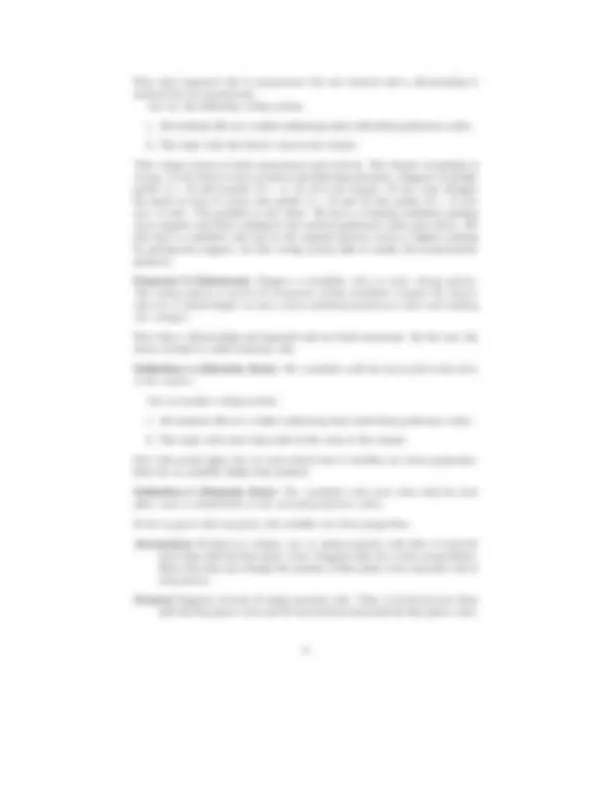
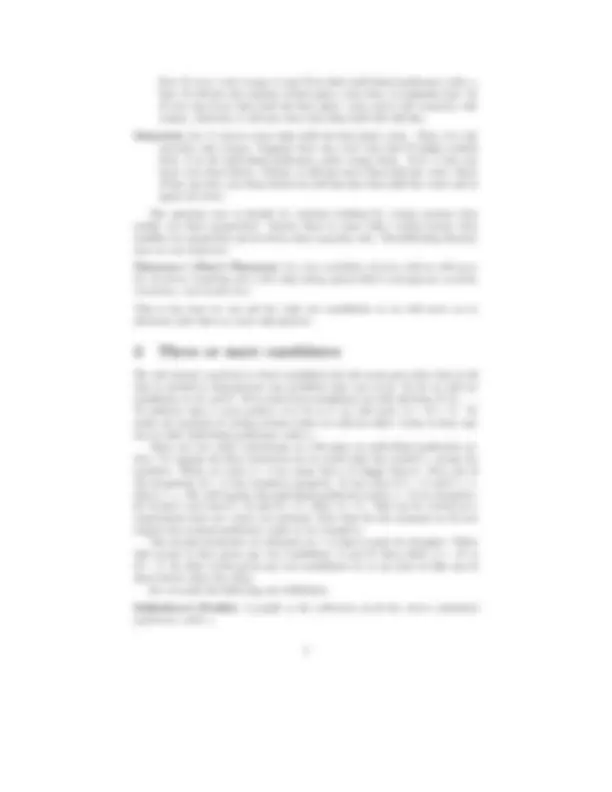
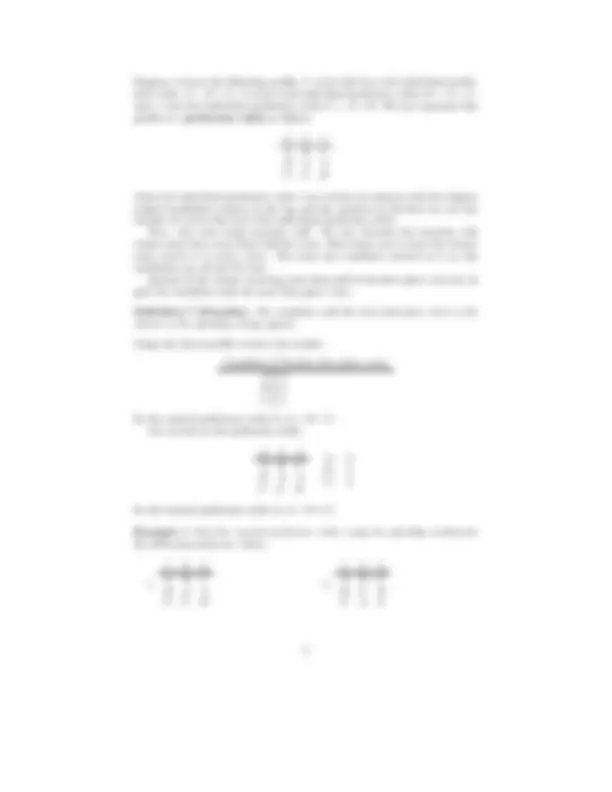
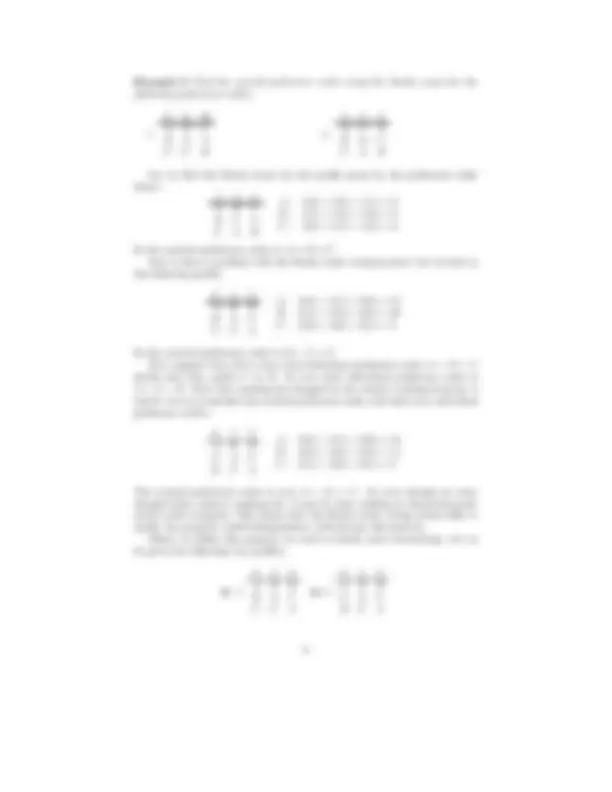
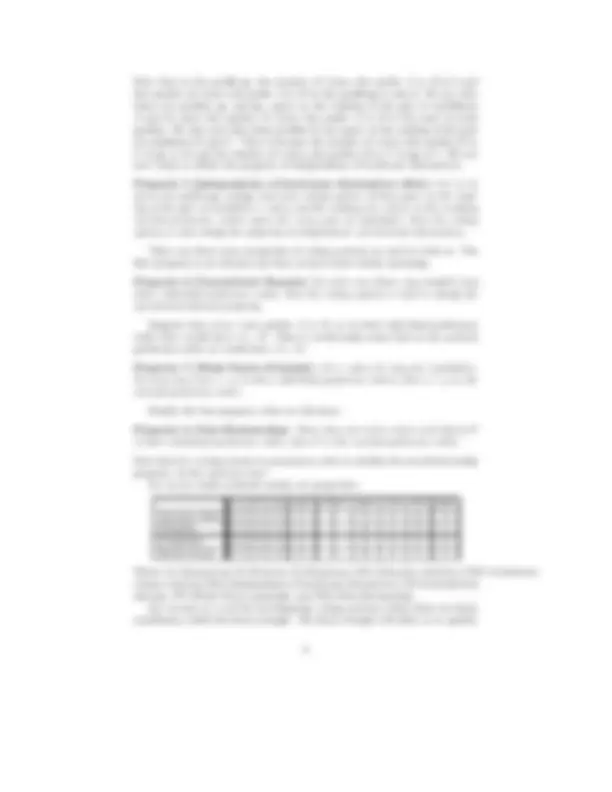
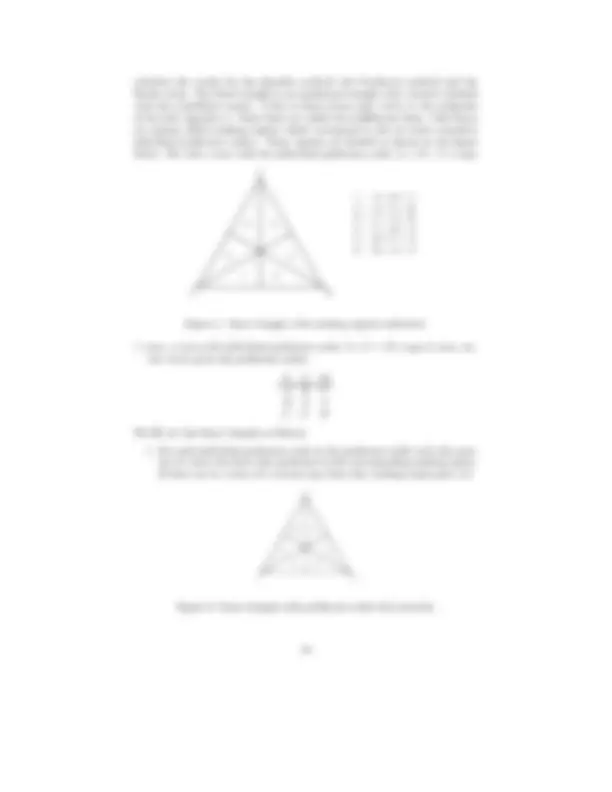
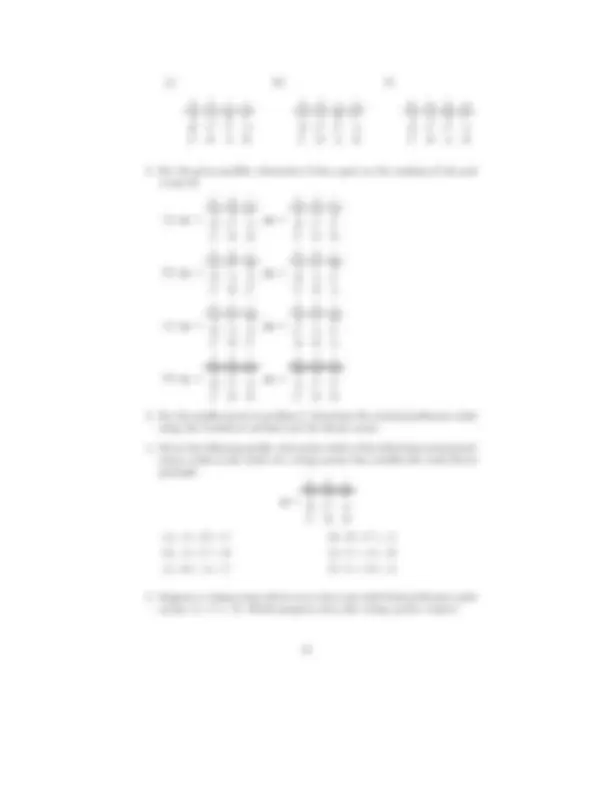
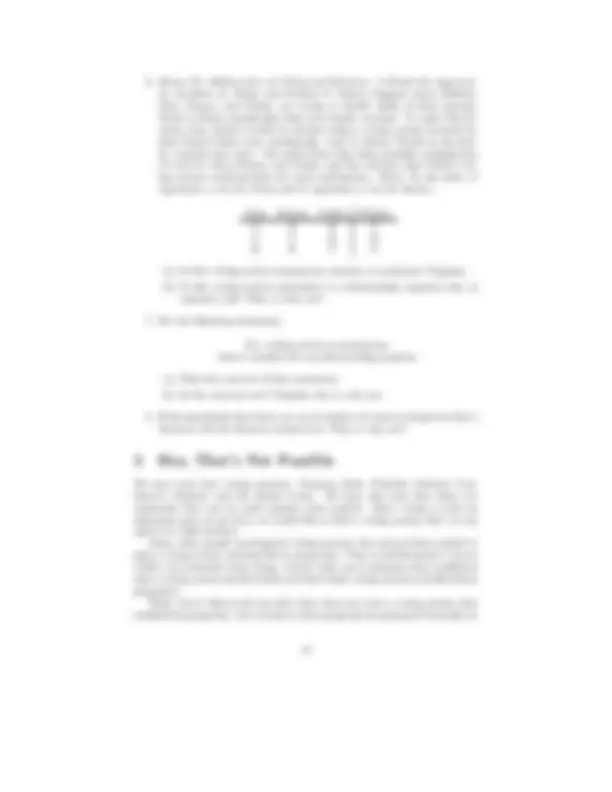
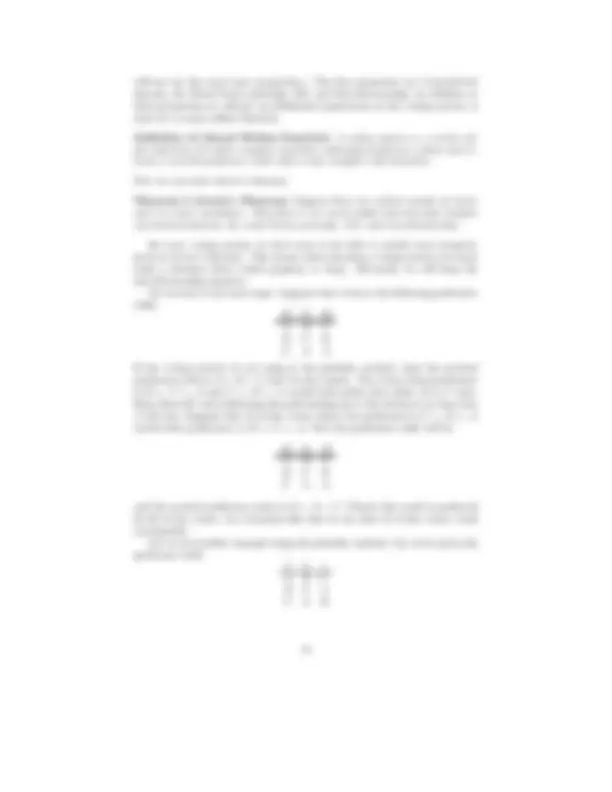


Study with the several resources on Docsity

Earn points by helping other students or get them with a premium plan


Prepare for your exams
Study with the several resources on Docsity

Earn points to download
Earn points by helping other students or get them with a premium plan
Community
Ask the community for help and clear up your study doubts
Discover the best universities in your country according to Docsity users
Free resources
Download our free guides on studying techniques, anxiety management strategies, and thesis advice from Docsity tutors
An in-depth analysis of various voting systems, focusing on their properties of anonymity, neutrality, monotonicity, and the condorcet winner. The concepts of imposed rule, majority rule, plurality, condorcet method, and borda count. It also includes examples and preference tables to illustrate the concepts.
Typology: Assignments
1 / 17

This page cannot be seen from the preview
Don't miss anything!










Suppose a class is given two options as to what the next topic to be covered will be.
A Cover voting theory.
B Cover the basics of algebraically closed fields of characteristic 0.
The first method I would like to propose is the following:
Is this a good method of letting the students determine the next topic to cover? If not, what is wrong? Before we answer this let us define a few terms that will be used in our investigation of voting systems. First we should define what a voting system is. A voting system is a procedure that given a set of voters preferences and a set of candidates determines in a nonrandom manner a ranking of the candidates. What do we mean by a voters preference? Suppose we have two candidates called A and B. There are three possible preferences a voter can have concerning these alternatives: A is preferred to B, B is preferred to A, or the voter is indifferent. Let us introduce some notation for preferences. If a voter prefers A to B we will write A ≻ B and if the voter is indifferent between A and B we write A ≈ B. This notation is meant to imitate the notation use for numbers: > and =. Each voter has what is called an individual preference order. So for a two candidate election there are only three possible orders:
A ≻ B, B ≻ A, A ≈ B.
The result of the voting system is called the societal preference order. For two candidates the possible orders for the societal preference order is the same as for the individual preference orders: A ≻ B, B ≻ A, and A ≈ B.
Now back to the voting system introduced above. The idea of voting is to determine the “will of the voters”. As a general rule this should mean that all the voters individual preference orders should be taken into consideration and that their votes are counted equally. The above method is called a dictatorship. Let us define what a dictator is.
Definition 1 (Dictator) A dictator is a voter whose preference is the only one considered when determining the winner in an election.
Let us define the above voting system.
Definition 2 (Dictatorship) In a dictatorship the societal preference order is determined by considering only one individual preference order, the individual preference order of the dictator.
So the problem with a dictatorship is that it does not satisfy the property that the voters should be treated equally. Let us call that property anonymity.
Property 1 (Anonymous) A voting system is anonymous when any two vot- ers swap ballots the societal preference order does not change.
Since a dictatorship fails to satisfy a property that everyone agrees is desirable lets look for another method. For our next method I propose the following:
Is this voting system anonymous and if it is can you find something else wrong with it? First let us determine if it is anonymous. It turns out that it is anonymous. It does not matter which students swap ballots the result will always be the same. So all voters are being treated equally. But it is clear that there is something wrong with this voting system. To find out what the problem is let us be precise in the definition of this voting system.
Definition 3 (Imposed Rule) In an imposed rule voting system a candidates rank in the societal preference order is determined without considering their rank in the voters individual preference order s.
Since the voters are all treated equally in imposed rule we need to find another problem. The problem is that the candidates are not treated equally since they do not all have the same opportunity to win. A voting system that gives every candidate an equal chance to win is said to satisfy the property of neutrality.
Property 2 (Neutral) A voting system is said to be neutral if whenever every voter swaps the rankings of the same two candidates in their individual prefer- ence order s those candidates rankings swap in the societal preference order.
Now if every voter swaps A and B in their individual preference order s, then B will get the number of first place votes that A originally had. So B now has more then half the first place votes and is the majority rule winner. Likewise A will now have less than half will will lose.
Monotone Let A receive more than half the first place votes. Then A is the majority rule winner. Suppose that one voter who had B higher ranked than A in his individual preference order swaps them. Now A has one more vote than before. Clearly A still has more than half the votes. Since B has one less vote than before he still has less than half the votes and is again the loser. The question now is should we continue looking for voting systems that satisfy our three properties? Maybe there is some other voting system that satisfies our properties and is better than majority rule. The following theorem says we can stop now.
Theorem 1 (May’s Theorem) In a two candidate election with an odd num- ber of voters, majority rule is the only voting system that is anonymous, neutral, monotone, and avoids ties.
This is the best we can ask for with two candidates so we will move on to elections with three or more alternatives.
We will restrict ourselves to three candidates for the most part since that is all that is needed to demonstrate any problems that can occur. So let us call our candidates A, B, and C. If we need more candidates we will call them D, E,.... To indicate that a voter prefers A to B to C we will write A ≻ B ≻ C. To make our analysis of voting systems easier we will not allow voters to have any ties in their individual preference order s. There are two other restrictions we will place on individual preference or- ders. To explain the first restriction let us recall what the symbol > means for numbers. When we write a > b we mean that a is bigger than b. Now one of the properties of > is the transitive property. It says that if a > b and b > c, then a > c. We will require the individual preference order s ≻ to be transitive. So if some voter hasA ≻ B and B ≻ C, then A ≻ C. This can be viewed as a requirement that our voters are rational. Note that for the moment we do not require the societal preference order to be transitive. The second restriction we will place on ≻ is that it must be complete. What this means is that given any two candidates A and B then either A ≻ B or B ≻ A. In other words given any two candidates we ca say that we like one of them better than the other. Let us make the following new definition.
Definition 6 (Profile) A profile is the collection of all the voters individual preference order s.
Suppose we have the following profile: 3 voters that have the individual prefer- ence order A ≻ B ≻ C, 2 voters with individual preference order B ≻ A ≻ C, and 1 voter has individual preference order C ≻ A ≻ B. We can represent this profile as a preference table as follows.
3 2 1 A B C B A A C C B
where the individual preference order s are written as columns with the highest ranked candidates written at the top and the numbers in the first row are the number of voters that have that individual preference order. Now, who wins using majority rule? No one, because the majority rule winner must have more than half the votes. Since there are 6 voters the winner must receive 4 or more votes. The most any candidate receives is 3, so the candidates are all tied for last. Instead of the winner receiving more than half of the first place votes let us pick the candidate with the most first place votes.
Definition 7 (Plurality) The candidate with the most first place votes is the winner in the plurality voting system.
Using the above profile we have the results:
Candidate Number first place votes A 3 B 2 C 1
So the societal preference order is A ≻ B ≻ C. Let us look at the preference table:
3 2 2 A B C B A A C C B
So the societal preference order is A ≻ B ≈ C.
Example 1 Find the societal preference order using the plurality method for the following preference tables.
using the Condorcet method, in both examples candidate B lost. We call B the Condorcet loser. This leads us to the following definitions.
Definition 9 (Condorcet Winner) The Condorcet winner is a candidate that beats every other candidate in a pairwise majority rule contests.
Definition 10 (Condorcet Loser) The Condorcet loser is a candidate that loses to every other candidate in a pairwise majority rule contests.
This gives us another property.
Property 4 (Condorcet Winner Criterion (CWC)) A voting system sat- isfies the Condorcet winner criterion if the voting system ranks the Condorcet winner in first place whenever the Condorcet winner exists.
So this voting system seems to be a good method to use. Are there any problems? Let us apply the Condorcet method to the following preference table.
1 1 1 A B C B C A C A B
This gives the result A ≻ B ≻ C ≻ A. So we have a cycle and therefore no winner. This is not a very desirable property for a voting system. So what else can we try? Let us look at the individual preference order A ≻ B ≻ C. So A ≻ B and A ≻ C. In Condorcet’s method the amount that this voter prefers A to B is the same as the amount that they prefer A to C. But it seems reasonable to say that this voter prefers A more to C than they prefer A to B. Let us see if we can find a voting system that utilizes this information. Suppose we give a candidate 2 points for every first place ranking the get, 1 point for each second place vote, and 0 points for each last place ranking. We then add the points for each candidate and the candidate with the most points wins. Let us look at an example.
3 2 1 A B C B A A C C B
So the societal preference order is A ≻ B ≻ C. This voting system is called the Borda count.
Definition 11 (Borda Count) Suppose we have m candidates. Each candi-
date receives m − i points for every ith place ranking. Next sum up the points for each candidate. The candidate with the most points is ranked first in the societal preference order. The candidate with the second most points is ranked second, etc.
Example 3 Find the societal preference order using the Borda count for the following preferences tables.
Let us find the Borda count for the profile given by the preference table below. 1 1 1 A B C B C A C A B
So the societal preference order is A ≈ B ≈ C. Now is there a problem with the Borda count voting system? Let us look at the following profile:
6 4 3 A B B B A C C C A
So the societal preference order is B ≻ A ≻ C. Now suppose that all 6 voters with individual preference order A ≻ B ≻ C decide that they prefer C to B. So now their individual preference order is A ≻ C ≻ B. Note that nothing has changed in the relative ranking between A and B. Let us recalculate the societal preference order with these new individual preference orders.
6 4 3 A B B C A C B C A
The societal preference order is now A ≻ B ≻ C. So even though no voter changed their relative rankings for A and B, their ranking in thesocietal pref- erence order swapped. This means that the Borda count voting system fails to satisfy the property called Independence of Irrelevant Alternatives. Before we define this property we need to clarify some terminology. Let us be given the following two profiles:
p 1 =
p 2 =
calculate the results for the plurality method, the Condorcet method and the Borda count. The Saari triangle is an equilateral triangle with vertices’s labeled with the candidates names. A line is drawn from each vertex to the midpoint of the side opposite it. These lines are called the indifference lines. This forms six regions called ranking regions which correspond to the six strict transitive individual preference orders. These regions are labeled as shown in the figure below. We call a voter with the individual preference order A ≻ B ≻ C a type
A B
C
1
2
3 4
5
6
1 : A ≻ B ≻ C 2 : A ≻ C ≻ B 3 : C ≻ A ≻ B 4 : C ≻ B ≻ A 5 : B ≻ C ≻ A 6 : B ≻ A ≻ C
Figure 1: Saari triangle with ranking regions indicated.
1 voter, a voter with individual preference order A ≻ C ≻ B a type 2 voter, etc. Let us be given the preference table:
6 3 10 A B C B A A C C B
We fill out the Saari triangle as follows:
A B
C
6
0
10 0
0 3
Figure 2: Saari triangle with preference table data entered.
A B
C
6
0
10 0
0 3
0 + 10 + 0 = 10
6 + 3 + 0 = 9
10 + 0 + 6 = 16 0 + 0 + 3 = 3
0 + 0 + 10 = 10
3 + 6 + 0 = 9
Figure 3: Saari triangle with data summed along indifference lines.
A B
C
6
0
10 0
0 3
10
9
16 3
10
9
Figure 4: Saari triangle with relevant information.
We can now use the Saari triangle to find the societal preference order (if it exists) using the plurality method, Condorcet method, and the Borda count.
Plurality To find A’s plurality score add the numbers in the light gray regions of the Saari triangle, B’s score will be the sum of the numbers in the dark gray region, and C’s score is the sum of the numbers in the white region, Figure 5. So |A| = 6, |B| = 3, and C = 10. Therefore the societal preference order for the plurality method is C ≻ A ≻ B.
Condorcet To find the pairwise rankings we look at the numbers on the outside of the Saari triangle. For our example we have
A B A C B C 16 3 9 10 9 10
So our societal preference order is C ≻ A ≻ B.
(j)
3 2 1 1 A A B C B C C A C B A B
(k)
3 2 1 2 A A B C B C C A C B A B
(l)
3 2 3 4 A A B C B C C A C B A B
(a) p 1 =
, p 2 =
(b) p 1 =
, p 2 =
(c) p 1 =
, p 2 =
(d) p 1 =
, p 2 =
p =
(a) A ≻ B ≻ C (b) A ≻ C ≻ B (c) B ≻ A ≻ C
(d) B ≻ C ≻ A (e) C ≻ A ≻ B (f) C ≻ B ≻ A
Zoey Emma Caden Winner P K K P P P K K K K P P
(a) Is this voting system anonymous, neutral, or monotone? Explain. (b) Is this voting system equivalent to a dictatorship, imposed rule, or minority rule? Why or why not?
If a voting system is anonymous, then it satisfies the non-dictatorship property.
(a) Find the converse of that statement. (b) Is the converse true? Explain why or why not.
We have seen four voting systems: Majority Rule, Plurality Method, Con- dorcet’s Method, and the Borda Count. We have also seen that there are arguments that can be made against each method. Since voting is such an important part of our lives, we would like to find a voting system that we can agree is a valid method. Many other people investigated voting systems, but each of them tended to pick a voting system and describe its properties. That is until Kenneth J Arrow (1921-) an economist came along. Arrow’s idea was to propose some conditions that a voting system should satisfy and find which voting systems satisfied those properties. What Arrow discovered was that there does not exist a voting system that satisfied his properties. Let us look at what properties he proposed (Actually we
The societal preference order is A ≈ B ≻ C. The last voter would prefer A to B. Suppose he switches his true preference C ≻ 5 A ≻ 5 B to the preference A ≻ 5 C ≻ 5 B. Now the preference table is
2 2 1 A B A B C C C A B
and the societal preference order is A ≻ B ≻ C. So by giving a false preference order voter v 5 has changed the result to one more favorable to him. What about the Borda count method? Can it be manipulated strategically? Suppose we have the preference table (taken from Comparing Voting Systems, Hannu Nurmi) 1 1 1 A B D B D A C C B D A C
So |A| = 5, |B| = 6, |C| = 2, and |D| = 5. Now if the last voter, v 3 , switches their true preference D ≻ 3 A ≻ 3 B ≻ 3 C to the strategic preference A ≻ 3 C ≻ 3 D ≻ 3 B the societal preference order will more closely reflect their preference. So the Borda count is also susceptible to strategic voting. Condorcet’s method is also susceptible to strategic voting. Let the preference table be (also pilfered from Comparing Voting Systems, Hannu Nurmi)
1 1 1 C B A B A C A C B
So the result is A ≻ C ≻ B ≻ A, a cycle. If ties are allowed in the individual preference orders we can construct the preference table
1 1 1 C A, B A B C A C B
So A ≈ B ≻ C. This result is clearly preferred by voter v 2.
(a) Unrestricted domain. (b) Weak Pareto principle. (c) Independence of irrelevant alternatives. (d) Non-dictatorship.
(a)
(b)
(c)
(d)